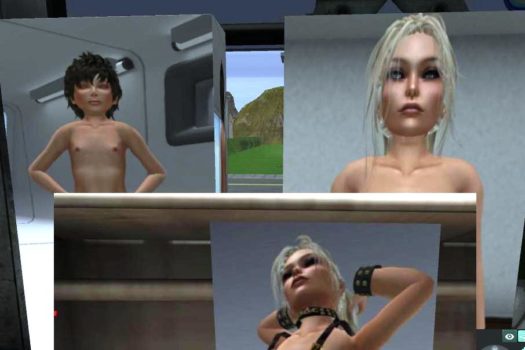
The Sacrarium grid has taken down illegal content after receiving complains from users through emails and forums, and removed users who allegedly engaged in illegal behavior with child avatars.
Neustadt, a region in Sacrarium grid and which was selling naked child avatars and had children avatars moving around naked, wearing BDSM harnesses and other inappropriate clothing, has been closed for public awaiting action from the owner to remove inappropriate content.
The Sacrarium grid has also notified the owner of the Adachi region, which was recently accused of copyright violation allegations, instructing them to remove allegedly stolen content on copyright grounds.
“The owner of Adachi has already reported on the elimination of violations,” grid owner Whiteangel Deed told Hypergrid Business. “Neustadt is still under redacting and closed for visitors.”
A user has also contacted the grid complaining that he had witnessed sexual activity involving an adult avatar and a child avatar at the Neustadt region. The grid was also accused through Opensimworld forums for the two regions for supporting stolen content and hosting pedophile related content.
“We immediately banned the both users,” Deed said. “Then several others users were banned who used avatars of naked children. Sacrarium is 18-plus grid and and it is not for children.”
Bad actors hop between grids
The Adachi region was previously on the Metropolis grid before it was banned there.
Other regions that have since moved to Sacrarium include Afes, Paradox, and Fashionistas Island, which was recently deleted from Kitely for violating grid’s content copyright terms.
Now that Sacrarium has also removed the abusers, other grids will need to keep an eye out for them, to avoid the kind of public relations problems that Kitely and Sacrarium have experienced as a result of the illegal content.
And the problems haven’t been limited to angry letters and social media posts, and haven’t all gone away once Sacrarium removed the content and the violators.
“Right after that, we were subjected to anonymous attacks by hackers,” Deed said. “It seems that the pedophiles lost access to Sacrarium and tried to take revenge.”
The grid has had to file complains with the police as a result of fears that the attackers could be “associated with the Nazi lobby,” he added. “Currently, we cannot disclose some details, since we signed the commitment to non-disclosure in the investigation. But later, when the investigation is completed, no doubt some details will be disclosed.”
How to file takedown requests through proper channels
Social media complaints of infringing content and bad behavior can spur grids to take action. But most prefer to see actual concrete evidence before taking any drastic steps such as removing content or users because false allegations can also cause damage.
Sacrarium’s content infringement process is outlined on their FAQ page and in their Terms of Service.
Some grids make it even easier. Kitely, for example, has a simple form for users to fill out to file a DMCA request. That form asks for the real, legal name of the content owner, which is required under the law. For example, the original creator might have given permission for content to be used somewhere, and some random anonymous person might not be aware of the deal. There’s no way to know for sure without checking with the original creator.
That means if the complaint doesn’t come from the original creator, the grid has to go through a lot of extra work to figure out if the content is, in fact, distributed illegally.
The complaints that Sacrarium has addressed so far required a week each to verify, for example.
Complaints that come with supporting documents are easier to process, especially if they include details of where the content is located, and affirms the identity of the actual copyright holder whose intellectual property rights are being infringed.
Once the grid has all this information, it can take action.
“Not only objects will be deleted, but also some users, as well as regions that do not meet our requirements,” Deed said.
Almost every country has laws in place similar to the US DMCA law, which requires infringing content to be removed, and provides protections against lawsuits for grids that remove such content promptly. Grids that fail to remove content lose the protection of those laws, and can then be sued by copyright holders.
The main difference between the US DMCA law and the equivalent laws of other countries is that the U.S. requires that a company register, which costs just $6. Any company anywhere in the world can file for a DMCA registration to protect itself against lawsuits by American users, and since U.S. requirements are stricter than those elsewhere, complying with U.S. DMCA will usually be more than sufficient for every other jurisdiction. Read more about it here. Kitely, for example, which is based in Israel, has registered.
However, grids don’t have to wait for formal DMCA requests in order to take down content if they have good reason to.
Recently, Kitely and DigiWorldz removed content from their grids without formal DCMA reports, after confirming the content was being used illegally. For example, DigiWorldz owner Terry Ford personally tracked down and contacted the original creator of some disputed content in Second Life.
Obviously, that’s not a process that can scale well. Especially for large grids with a lot of content, expecting grid owners to monitor social media, identify the provenance of content, then track down the original creators is unrealistic.
To make things easier for content creators, we maintain a list of intellectual property policies on all the major grids. If your grid’s information is missing, please email me at david
- OpenSim active users hit all-time-high for the holidays - December 15, 2023
- OpenSim user activity ramping up for the holidays - November 15, 2023
- OpenSim land area at a new high as grids prep for holidays - October 15, 2023
